This is the third post in my never-ending series on the Flash. My first post was on Flash Rebirth, and I was not very kind. To understand where all this nostalgia for the Flash was coming from, I began reading the Silver Age Flash stories, starting with the debut of Barry Allen in Showcase #4 (1956). For this week, I’ll be reviewing the first three issues of The Flash.
Quick history lesson: Barry Allen was the star of Showcase for ten more issues before DC Comics gave him his own series. Flash #105 debuted in March 1959, retaining the numbering of the original Flash Comics from the 1940s. The earliest issues of the Flash were all written by John Broome and drawn by Carmine Infantino. Joe Giella provided most of the inking.
Flash #105
As with Showcase, the early Flash issues contain two stories apiece. The first story in #105 wasn’t very memorable, though it wasn’t terrible either. It’s one of those stories where an archaeologist digs up an ancient villain from a forgotten, hyper-advanced civilization. The ancient villain, Katmos, plans to conquer the world, and (spoiler alert!) the Flash stops him. Katmos is a boring villain, but there is one great scene where he tries to use a mind control ray on an unsuspecting civilian and ends up enhancing the guy’s intelligence by mistake.
As I mentioned last week, I appreciated how these early Flash stories embraced the inherently ridiculous nature of the superhero genre. There’s no grim n’ gritty posturing, no contempt for young readers, no oppressive reverence for the past (then again, Barry Allen was introduced with an extended call-back to the 1940s Flash. But there isn’t any real connection to the original Flash except the name, similar powers, and a cutesy nod to Flash Comics. Because there is no actual continuity, this comic hasn’t degenerated into a continuity quagmire … yet). It’s a book that’s comfortable being popcorn entertainment for kids, and that makes the limitations of the storytelling and art somewhat more forgivable.
And look, the hero is getting emasculated by his clueless girlfriend! that never gets old.
While Superman took pleasure in repeatedly humiliating Lois, the Flash just takes Iris’s abuse. I suspect she got off easy not because Broome and Infantino cared about Iris, but because they didn’t have that all-too-common intense loathing of the fairer sex. It’s not so much hate as mild contempt: Iris was an accessory, like the capsule ring or the Flash costume. She’s there so that Barry can bask in a woman’s praise of the Flash without her knowing that Barry is actually the superhero. Secret identities and male egos are preserved.
I preferred the second story, which introduced one of Flash’s better villains – Mirror Master. As his name suggests, Mirror Master uses mirrors to create false images that can interact with the physical world. It’s silly comic book pseudo-science, but the mirror images are limited by rules that are easy for young readers to grasp. For example, a mirror image of a person will be an exact duplicate except that asymmetrical features like watches or the part in someone’s hair will be on the wrong side.
And since a mirror image can’t exist without the reflection of light, Flash defeats the Mirror Master by simply turning the lights off.
Flash #106
Broome and Infantino continue to improve their comic with the next issue. The first story introduces Gorilla Grodd, a shining example of the narrative theory called “apes make everthing better.” The plot, if you can call it that, is a series of increasingly absurd moments that are nevertheless easy to follow. An actor who plays a gorilla is worried that he’s unconsciously causing trouble while dressed in his gorilla costume (stuff like this happens when apes are involved). He asks his friend Barry for help, and Barry investigates as the Flash. He runs into Grodd, a villain from a hidden race of hyper-intelligent gorillas from Gorilla City. The city is located in Africa, presumably near the Country of Africa just south of Africa City.
Grodd is pursuing another ape, Solivar, who was captured by poachers and sold to a circus where he’s been masquerading as a regular gorilla (hyper-intelligent maybe, but not very bright). Grodd steals Solivar’s intelligence with his telepathy so he can conquer the gorillas and then use them to conquer the world. Flash teams up with Solivar and beats Grodd by using his powers in the most obvious but effective way: he runs really fast so Grodd can’t see him coming.
The art remains a cut above competent, but Infantino never really goes crazy with depicting speed powers. For the most part, it remains speed-lines and largely empty panels that imply the rapid transition of time.
The second story isn’t as good, but it’s a half-way decent introduction of another Flash rogue, the Pied Piper. There are also these great Flash Facts pages with random speed-related info. This comic has everything a nerdy kid could want.
Flasth #107
Realizing that they have a hit on their hands, Broome and Infantino use Grodd again as the primary villain. Grodd escapes from Gorilla City and flees to the center of the Earth, which is hollow (Neal Adams was right!). Grodd plans to brainwash a race of bird men to help him conquer the world, but Solivar recruits Flash to stop him. Flash does that vibrational thing where he moves through solid matter, and he fights Grodd … at the center of the world!
Of course, Flash escapes and he beats up the ape. Broome rights a decent fantasy adventure, but Infantino really drops the ball when it comes to envisioning the hollow Earth. It just looks like a generic, barren landscape with a pink sky.
Later, he adds a couple of vaguely sci-fi houses to the background, but the art is never as exciting as it could be. Last week, I described Infantino’s art as “eye-catching,” and I stand by that. He can draw big, splashy panels when he needs to and he knows how to arrange an action sequence. But his imagination seems very limited.
I’ll continue my review of Silver Age Flash in a couple weeks, focusing on the famous issues that, for better or worse, defined the series.

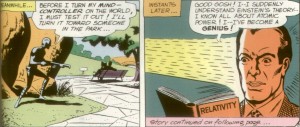
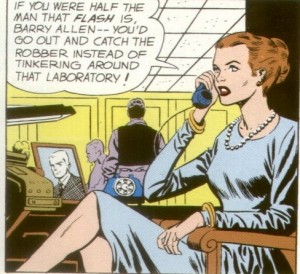
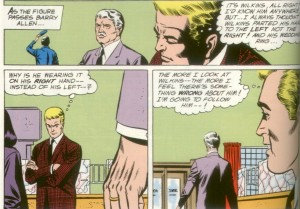
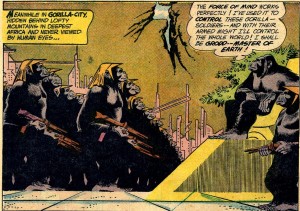
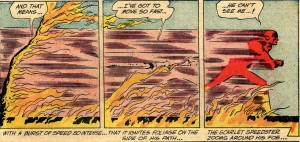
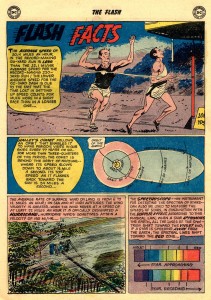
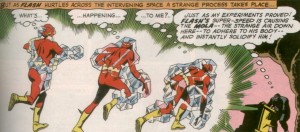

Richard, what a delight these posts of yours are to this aging schlub– an aging schlub who can, thanks to you, recall the six-year-old transfixed by delightin a dentist’s waiting-room…prisoner of the Flash!
More, more, more!
(But you can stop short of Mopee…if you don’t understand that, you– shudder– will…)
Infantino gets better (and he did a mean Supergirl too, I think). Sadly, he was still around when the Flash descended into continuity hell some 200 issues later. (Anyone who remembers “The Trial of the Flash” knows whereof I speak).
Thanks Alex. I have no idea who Mopee is, but now that you’ve brought it up I must find out.
Eric- I actually really want to read the transition to continuity hell. Maybe I’m just a masochist, but I’m also curious how it occurs. Was it all of a sudden, or a slow build up of stories that kept getting referenced, like the X-Men?
Sadly, I don’t know…as my Flash collection is far far from complete. Somebody out there knows, but it ain’t me.
thanks for the post! wow Iris has a serious case of Vagina Dentata LOL
Pingback: Speed Reading: Merit Badges, Plush Flash, Sonic Month and More « Speed Force